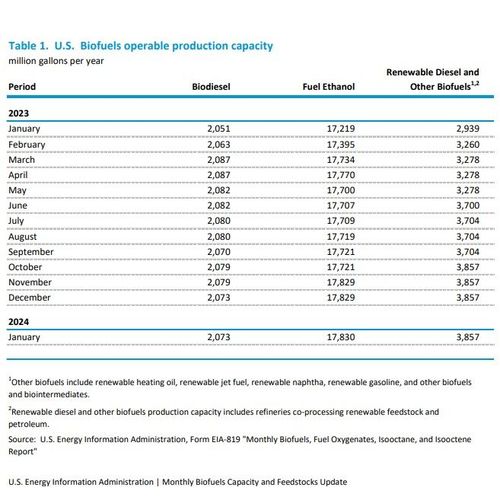EIA: US biofuel capacity remains steady in January

SOURCE: U.S. Energy Information Administration
April 1, 2024
BY Erin Voegele
U.S. biofuels operable production capacity was unchanged in January, according to data released by the U.S. Energy Information Administration on March 29. Total feedstock consumption was down when compared to the previous month.
Total U.S. biofuels capacity was at 23.759 billion gallons per year in January, up 1 MMgy when compared to December. When compared to January 2023, capacity was up 1.551 billion gallons per year with gains for biodiesel, ethanol and renewable diesel.
Fuel ethanol production capacity reached 17.83 billion gallons per year in January, up 1 MMgy when compared to the previous month and up 611 MMgy when compared to January 2023.
Biodiesel capacity was at 2.073 billion gallons per year in January, flat with the previous month, but up 22 MMgy when compared to January 2023.
Advertisement
Advertisement
Capacity for renewable diesel and associated biofuels, including renewable heating oil, renewable jet fuel, renewable naphtha, renewable gasoline and other biofuels and biointermediates, was at 3.857 billion gallons per year in January, a capacity level that has been maintained since October 2023. When compared to January 2023, capacity for renewable diesel and associated fuels was up 918 MMgy in January 2024.
Total biofuel feedstock consumption for January reached 27.745 billion pounds, down from 30.503 billion pounds in December, but up slightly from 27.154 billion pounds in January 2023.
The consumption of feedstock commonly used to produce ethanol in January was down when compared to both the previous month and the same month of last year. The consumption of feedstock commonly used to produce biobased diesel and associated biofuels in January was down when compared to December, but up when compared to January 2023.
U.S. biofuel producers consumed 24.7 billion pounds of corn in January, down from 27.104 billion pounds in December, but up slightly from 24.964 billion pounds in January of last year. Grain sorghum consumption was at 76 million pounds in January, up from 48 million pounds the previous month, but down from 364 million pounds in January 2023.
According to EIA, biofuel producers consumed 960 million pounds of soybean oil in January, including 545 million pounds consumed by biodiesel plants and 416 million pounds consumed by renewable diesel producers. Soybean oil consumption was t 1.141 billion pounds in December, with 603 million pounds consumed by biodiesel producers and 539 million pounds consumed by renewable diesel producers, and at 941 million pounds in January 2023, with 557 million pounds consumed by biodiesel plants and 384 million consumed by renewable diesel producers.
Advertisement
Advertisement
Biofuel producers also consumed 376 million pounds of canola oil in January, up from 343 million pounds the previous month and 242 million pounds in January of the previous year. Biodiesel producers consumed 153 million pounds of canola oil in January, up from 150 million pounds in December. Renewable diesel plants consumed 224 million pounds of canola oil in January, up from 193 million pounds in December. The EIA did not begin breaking down canola oil consumption by biofuel producer type until August 2023, as such data on the volume consumed by biodiesel and renewable diesel producers in January 2023 is unavailable.
Corn oil consumption reached 335 million pounds in January, down from 349 million pounds in December, but up from 289 million pounds in January of last year. Biodiesel plants consumed 71 million pounds of corn oil in January, up from 63 million pounds the previous month, while renewable diesel plants consumed 264 million pounds of corn oil in January, down from 286 million pounds in December. Data on corn oil consumption by producer type is unavailable for January 2023, as the EIA did not begin providing that data until August 2023.
Biofuel producers consumed 631 million pounds of beef tallow, 616 million pounds of yellow grease, and 45 million pounds of white grease in January. Consumption was at 744 million pounds, 642 million pounds, and 40 million pounds, respectively, in December, and at 199 million pounds, 404 million pounds and 41 million pounds, respectively, in January 2023. The EIA withheld the volume of poultry fat consumed by biofuel producers in January to avoid disclosure of individual company data. Poultry fat consumption was at 15 million pounds in both December and January 2023. An additional 9 million pounds of feedstock classified as “other” waste oils, fats and greases was consumed in January, down from 17 million pounds the previous month.
The EIA withheld data on several feedstock types, including other agriculture and forestry products, other recycled feeds and wastes, and other biofuel feedstocks not elsewhere identified in order to avoid disclosure of induvial company data.
Additional data is available on the EIA website.
Related Stories
The USDA significantly increased its estimate for 2025-’26 soybean oil use in biofuel production in its latest World Agricultural Supply and Demand Estimates report, released July 11. The outlook for soybean production was revised down.
U.S. fuel ethanol capacity fell slightly in April, while biodiesel and renewable diesel capacity held steady, according to data released by the U.S. EIA on June 30. Feedstock consumption was down when compared to the previous month.
The U.S. EPA on July 8 hosted virtual public hearing to gather input on the agency’s recently released proposed rule to set 2026 and 2027 RFS RVOs. Members of the biofuel industry were among those to offer testimony during the event.
The USDA’s Risk Management Agency is implementing multiple changes to the Camelina pilot insurance program for the 2026 and succeeding crop years. The changes will expand coverage options and provide greater flexibility for producers.
The USDA’s National Agricultural Statistics Service on June 30 released its annual Acreage report, estimating that 83.4 million acres of soybeans have been planted in the U.S. this year, down 4% when compared to 2024.
Upcoming Events










